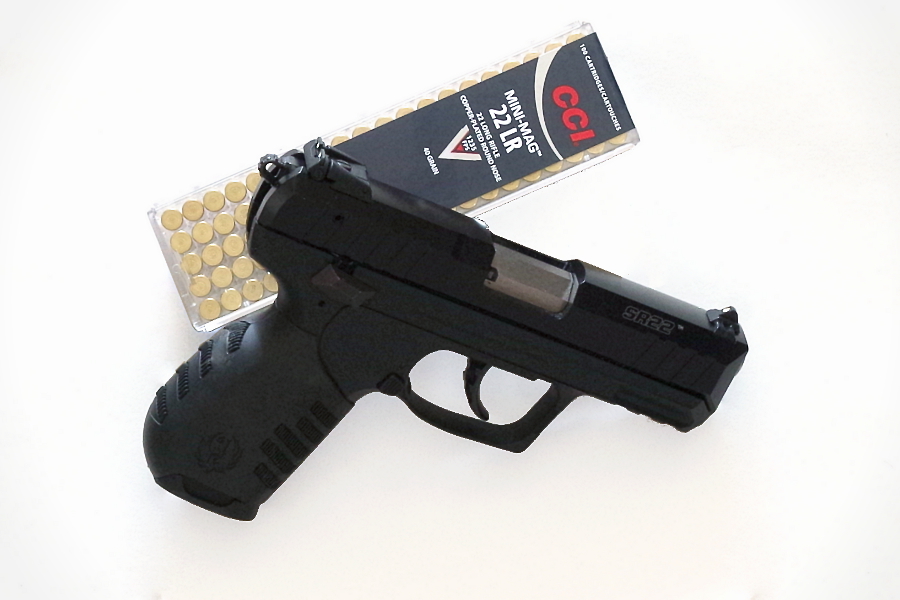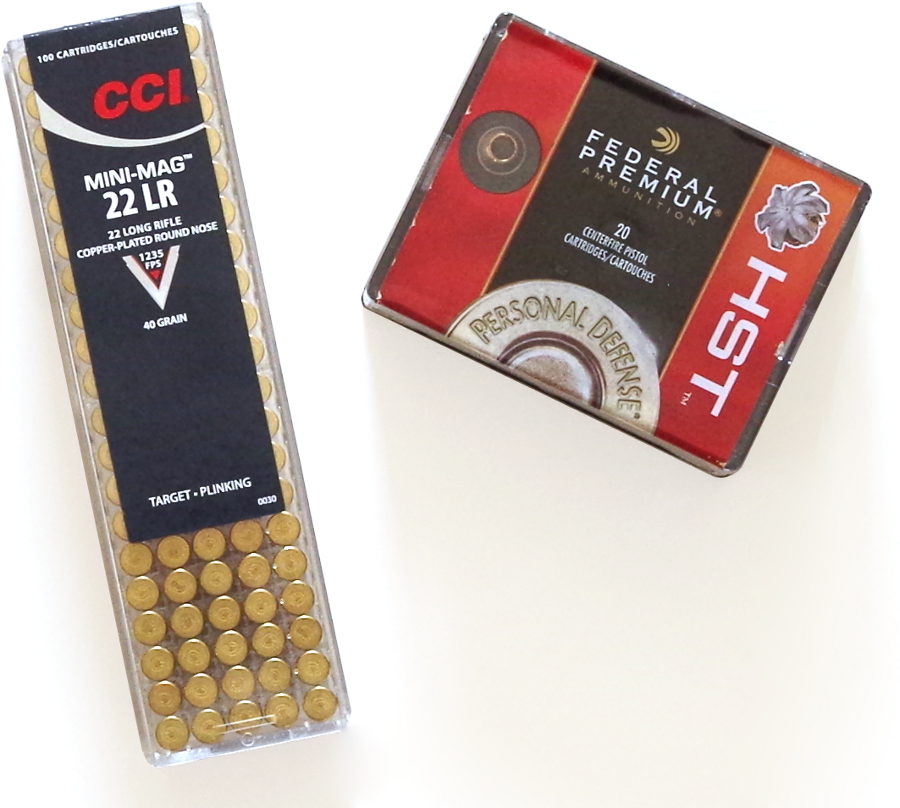
A gun probably similar to this one left a mark so small it wouldn’t be noticed for days. (Photo: Max Slowik)
The .22-caliber Blevins Incident
It took three days for one Florida man to realize that he’d been shot–by himself. He noticed the gunshot wound after putting on a lighter-colored shirt that showed stains from the bullet holes in his arm.
Police were called after Michael Blevins, 37, checked himself into a hospital to treat the injury, which at that point, had mostly stopped bleeding.
It’s the kind of situation most pet owners can imagine: Blevins said he was cleaning his pistol when his dog came to investigate. He pulled the gun up high against his chest so that the dog could not jump around it when his back went out.
That’s when he felt a sharp pain–not in his arm, but in his face, as he fell over and smashed into his glass coffee table. He said he remembered hearing a gunshot go off about the same time.
He told doctors and law enforcement that at no point was he bothered by the bullet wound–a possible side effect of the pain medication he was taking for an old back injury. The only thing that bothered him was his face above his left eyebrow where his head struck the table.
Florida deputies investigating the incident are confirming Blevins’ account and agree that he shot himself trying to keep his gun away from his curious dog. It was a .22-caliber pistol.
Teachable Moments
Please understand that we are not mocking Blevins, his life has already been torn up by this. It’s bad enough that people may use this to argue that gun ownership is self-destructive, gun owners can’t be trusted not to shoot themselves and so on. That’s literally adding insult to injury. If it hadn’t been a gunshot wound, if he dropped a knife through his foot and didn’t notice for three days, there wouldn’t even be a headline here.
This is just one person’s bad day of bad days. If there’s a bright side, it’s that it’s a reminder to everyone that when it comes to guns there is no such thing as being too vigilant about gun safety.
Part 1: the Four Rules
The first four rules of gun safety are:
- Always keep the gun pointed in a safe direction,
- Always keep your finger off the trigger until ready to shoot,
- Treat all guns as if they are loaded at all times and keep them unloaded until they’re ready for use,
- Know what’s your target and what’s behind your target.
This is basically a checklist of what went wrong for Blevins. While we can’t be 100 percent sure of what happened that day it’s clear that if a man shot himself trying to keep Rex from turning a pistol into a chew toy that each of the four rules was broken.
The thing about the rules of handling guns is that in order for someone to get hurt, in almost every case, more than one rule has to be broken. Outside of a firearm malfunction, even following just one of these rules can prevent an injury or death.
Lock the dog in the bathroom when you clean your guns, there’s water, he’ll make it. That’s an easy way to make sure that the gun stays pointed in a safe direction. This is perhaps the most important rule of gun handling. Guns can and do malfunction. They can get grimy and worn down. In some cases, these malfunctioning guns can fire even if no one pulls the trigger.
The gun doesn’t even have to be old and beaten to have this sort of problem. Big names in the industry have had issues with guns firing without anyone telling the gun to. Although just because under the worse circumstances, a gun may fire without pulling the trigger doesn’t mean trigger discipline is unimportant.
Trigger discipline–keeping fingers off triggers when not shooting–can take practice. So practice. Working on gun handling practice at home outside of the range is important. Teach yourself and others to pick up guns with their index finger on the frame or stock completely away from the trigger and out of the trigger guard.
This fits in with regular at-home practice including dry-fire practice, holster practice, and sling practice. When you’re at home, it’s not playing with guns. It’s practice.
Dry-fire practice by definition breaks one rule of gun safety. As long as the gun is unloaded and kept pointed in a sound direction, dry-fire practice is not only safe it helps shooters improve their trigger control, memorize their sight picture and work on other fundamentals like grip and stance. It’s a solid–not to mention free–way to get some trigger time in.
It also conditions shooters to check and re-check their guns to make sure they are not loaded. By assuming the gun is loaded at all times you start to dry-fire practice by locking open the slide, dropping the magazine and making absolutely sure the chamber is empty and that no ammunition is in the gun there to reload it. Unloading and making safe a gun should be as natural as shooting them.
Blevins was lucky in is bad luck. It could have been worse; the silver lining is that it is a reminder to us all to stay sharp when handling guns no matter what our level of experience is with them.

Which ammo is better for self-defense is undebatable but that won’t stop people from debating it. (Photo: Max Slowik)
Part 2: Rimfire is Not Adequate for Self-Defense
Maybe it wasn’t all luck for Blevins, though. Nobody is for a single second arguing that rimfire ammo is not deadly. Any .22 pistol can kill. Going by any set of numbers, .22 is one of the most common killers out there–but that’s because it’s cheap, it’s everywhere and people shoot it more than anything else.
We’ve all seen reports of shootings where the person shot was hit many, even dozens of times with modern self-defense ammunition and pulled through and also sad reports of accidental or negligent deaths caused by plinking rimfire ammo. That doesn’t make them equal to each other.
As a training round, a small-game getter, and general plinking cartridge .22 Long Rifle is king. But when it comes to protection and self-defense its potential to cause harm should not be confused with the ability to reliably stop an attack. Case in point: this guy took a .22 at point blank and failed to notice. Maybe he’s a bigger guy, maybe he’s got circulation problems, maybe he’s on a lot of drugs. All of that could be true of anyone in a self-defense situation.
There are many schools of self-defense that teach the idea of shooting to stop an attack, not shoot to kill. A lot of people argue that a violent aggressor will stop and run away at the sound of gunfire. Most reasonable people will change their behavior under fire–the problem is that most violent aggressors don’t fall into the category of “reasonable people.” Ammo needs to capable of demonstrably physically stopping a person, disabling them, breaking them, not just scaring them off.
And let’s face it, rimfire ammunition is not even demonstrably capable of functioning as reliably as centerfire ammo–otherwise we’d still be making centerfire-caliber rimfire ammo. The biggest problem with rimfire ammo is that where centerfire ammo would go bang, rimfire sometimes goes click. Producing dead-nuts reliable rimfire ammo is a tall order even for today’s ammo makers, and making a gun that will fire it with the kind of reliable feeding, firing, and extracting is just as tough.
So why limit yourself to a kind of cartridge with such a proven unreliable track record? Some people can only handle .22s. Or so they think. A lot of shooters believe they can’t handle the recoil of a more powerful cartridge. Unless they have a physical disability or health problem, chances are they can learn to shoot a handgun or light carbine chambered for a modern centerfire cartridge. It’s a matter of learning, practice and most importantly, confidence.
That does leave a small number of people who realistically can only use a rimfire gun for self-defense. And that’s where we’ll pick things up next. Until then, just remember this: a guy shot himself with a .22 and it was the bump to the head that really wrecked his day.